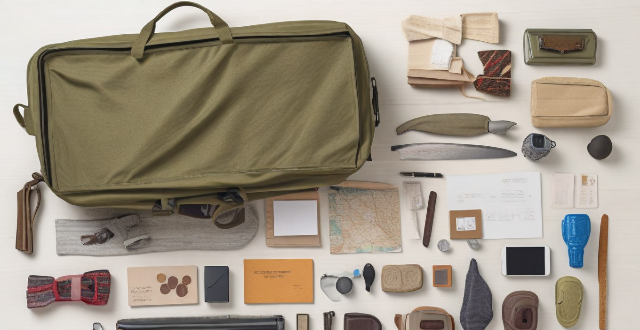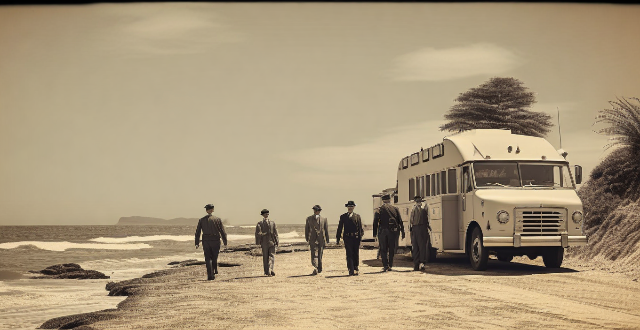Travel Carry

What should I pack in my carry-on luggage for a smooth airport experience ?
When packing your carry-on luggage, consider what you will need during the flight and at your destination. Pack documents and travel information, comfortable clothing and accessories, toiletries and personal care items, entertainment and electronics, snacks and water, cash and credit cards, a travel pillow, an eye mask and earplugs, a pen and paper, and a reusable shopping bag for souvenirs or dirty laundry. Check the airline's carry-on baggage policies before you travel to avoid any issues at the airport.

What should I include in my carry-on luggage for a long-haul flight ?
When packing your carry-on luggage for a long-haul flight, it's important to consider the items that will make your journey more comfortable and enjoyable. Here are some essential items to include: ### 1\. Personal Items - **Passport and travel documents**: Make sure to bring your passport, visa (if required), boarding pass, and any other necessary travel documents. - **Wallet and money**: Bring your wallet with cash, credit cards, and any currency you may need for your destination. - **Phone and charger**: Don't forget your phone and its charger, as well as any necessary adapters or converters for international use. - **Medication and health products**: If you have any medication or health products that you need during the flight, make sure to pack them in your carry-on luggage. - **Personal hygiene items**: Pack a small toiletry bag with items such as toothbrush, toothpaste, deodorant, hand sanitizer, and moisturizer. ### 2\. Comfort Items - **Snacks and drinks**: Bring some snacks and water to keep yourself hydrated and satisfied during the flight. - **Entertainment**: Pack a book, magazine, or e-reader to keep yourself entertained during the flight. You can also download movies or TV shows onto your device beforehand. - **Headphones or earbuds**: Bring headphones or earbuds to listen to music, watch movies, or block out noise during the flight. - **Travel pillow and blanket**: A travel pillow and blanket can help you get comfortable and restful during the flight. - **Eye mask and earplugs**: An eye mask and earplugs can help you block out light and noise, allowing you to sleep more easily during the flight. ### 3\. Clothing and Accessories - **Comfortable clothing**: Wear comfortable clothing on the flight, such as stretchy pants or leggings, a loose-fitting shirt, and comfortable shoes. - **Sweater or jacket**: Bring a sweater or jacket to keep yourself warm during the flight, especially if you tend to get cold easily. - **Socks and slippers**: Pack a pair of socks and slippers to keep your feet warm and comfortable during the flight. - **Sunglasses and hat**: Bring sunglasses and a hat to protect yourself from the sun when you arrive at your destination. ### 4\. Miscellaneous Items - **Reusable water bottle**: Bring an empty reusable water bottle to fill up after passing through security, rather than buying bottled water at the airport. - **Pen and paper**: Bring a pen and paper to jot down notes or ideas during the flight. - **Travel journal**: If you enjoy writing, consider bringing a travel journal to document your experiences during the trip. - **Small backpack or purse**: Use a small backpack or purse to store all of your carry-on items, making it easy to access them during the flight.

Who are the major companies involved in commercial space travel ?
Commercial space travel has become a reality with the advancements in technology, and several companies are making significant contributions to the industry. Major companies involved include SpaceX, Blue Origin, Virgin Galactic, Boeing, and Sierra Nevada Corporation (SNC). These companies are developing reusable launch vehicles and reliable rocket engines, as well as spacecraft designed to carry cargo and humans to and from low Earth orbit destinations such as the International Space Station. Their unique technologies and innovations aim to make space travel more accessible and affordable for both scientific research and tourism purposes.

How do I prepare a travel first aid kit for my next trip ?
When preparing for your next adventure, it's essential to pack a travel first aid kit. This will ensure that you are prepared for any unexpected injuries or illnesses that may occur while away from home. Here are some steps to follow when creating your own travel first aid kit: 1. Choose the right bag or container that is durable, compact, and easy to carry. A waterproof bag with multiple compartments and pockets is ideal as it allows for efficient organization of supplies. 2. Pack essential medical supplies such as bandages, antiseptic wipes, gauze pads, adhesive tape, and scissors. These items are crucial for treating cuts, scrapes, and other minor injuries. Include pain relievers, allergy medication, and motion sickness pills. 3. If taking regular medications, bring enough to last throughout the trip. Over-the-counter drugs like antacids, laxatives, and anti-diarrheal pills should also be packed, along with any prescription medications needed. 4. Depending on the destination and activities planned, specialized items may be necessary. For example, insect repellent, sunscreen, and blister kits are useful for hiking or camping trips. Anti-malarial medication and water purification tablets are important for tropical climates. 5. Customize the travel first aid kit based on individual needs. If allergies or chronic conditions exist, include appropriate medications and supplies. Don't forget to pack a small first aid manual or guidebook for reference in case of an emergency.

How can I be prepared for medical emergencies while traveling abroad ?
This text provides advice on how to be prepared for medical emergencies while traveling abroad. It suggests researching healthcare options, getting travel insurance, packing a travel medicine kit, learning basic first aid, knowing emergency numbers, staying healthy, and keeping important information handy.

How much does travel insurance usually cost ?
The cost of travel insurance can vary greatly depending on factors such as destination, duration of trip, coverage level, and individual characteristics like age and health condition. To find the best policy for your needs, compare policies from different insurers, look for discounts, consider annual plans if you travel frequently, and review exclusions and limitations carefully.

What are some essential travel safety tips for international tourists ?
Traveling to a foreign country can be an exciting adventure, but it's important to prioritize safety during your journey. Here are some essential travel safety tips for international tourists: ## Research Your Destination Before embarking on your trip, research the destination thoroughly. Familiarize yourself with local customs, laws, and cultural norms. This will help you avoid any misunderstandings or unintentional offenses that could put you in harm's way. ### Learn Basic Phrases in the Local Language Knowing how to say simple phrases like "hello," "goodbye," "thank you," and "I don't understand" in the local language can go a long way in helping you communicate with locals and navigate your way around. ### Check the Weather Forecast Be prepared for any weather conditions by checking the forecast before you leave. Pack appropriate clothing and gear to ensure your comfort and safety throughout your trip. ## Stay Informed About Safety Concerns Stay up-to-date on any safety concerns or travel warnings related to your destination. The U.S. Department of State maintains a website with current information on safety issues and advisories for travelers. ### Register With Your Embassy or Consulate Register your travel plans with your embassy or consulate so they can contact you in case of an emergency or natural disaster. This is especially important if you plan to visit remote areas where communication might be limited. ## Be Cautious With Your Belongings When traveling abroad, it's crucial to take precautions to protect your belongings from theft or loss. Here are some tips to keep your valuables safe: ### Keep Your Valuables Close at Hand Carry only what you need when sightseeing or exploring new places. Keep your passport, cash, credit cards, and other valuables secure in a money belt or hidden pocket. ### Use Hotel Safes Wisely Hotel safes are convenient for storing valuable items while you're out and about. However, be aware that not all hotel safes are foolproof. Some may have vulnerabilities that could allow thieves to access your belongings. Always exercise caution when using hotel safes and consider bringing along a portable lock for added security. ### Be Mindful of Your Surroundings Stay alert and aware of your surroundings at all times. Avoid displaying expensive jewelry or electronics in public places, as these items can attract unwanted attention from pickpockets and thieves. If possible, try to blend in with the local crowd by dressing conservatively and avoiding flashy accessories. ## Follow Local Laws and Customs Respecting local laws and customs is essential for staying safe while traveling abroad. Here are some tips to help you navigate this aspect of international travel: ### Obey Local Laws Familiarize yourself with the legal system and laws of the country you're visiting. This includes understanding the penalties for breaking the law, which can vary widely depending on the country. Remember that what might be legal in your home country could be illegal elsewhere. ### Respect Local Customs Be mindful of local customs and traditions when interacting with locals. Dress appropriately for religious sites and respect their rules regarding photography and behavior. Additionally, be aware of social norms regarding physical contact (such as handshakes or hugs) and follow them accordingly. ## Seek Medical Attention When Needed If you become ill or injured during your trip, seek medical attention promptly. Here are some tips to help you stay healthy while traveling: ### Pack a First Aid Kit Bring a basic first aid kit with essential items such as bandages, antiseptic wipes, pain relievers, and any prescription medications you might need. This will help you handle minor injuries and illnesses without having to search for medical supplies in an unfamiliar place. ### Know Where to Go for Medical Help Research nearby hospitals and clinics before you leave home so you know where to go if you need medical assistance during your trip. It's also a good idea to purchase travel insurance that includes coverage for medical emergencies.

Is space travel only for astronauts or can ordinary people go too ?
Space travel, once a distant dream, has become a reality with the advent of commercial spaceflight companies. However, the question remains: is space travel only for astronauts or can ordinary people go too? In the early days of space exploration, only highly trained astronauts were selected to venture into space. These individuals underwent rigorous training and selection processes to ensure their physical and mental fitness for the challenges of spaceflight. Over time, the landscape of space travel has changed significantly. Private companies have entered the arena, offering opportunities for ordinary people to experience spaceflight. This shift has opened up new possibilities for those who dream of exploring the final frontier. Several private companies have emerged in recent years, each with its own approach to space tourism. Some of the key players include Blue Origin, SpaceX, and Virgin Galactic. While space travel may seem like an extravagant luxury, there are several potential benefits for ordinary people who choose to embark on this adventure. These benefits include experiencing weightlessness, viewing Earth from space, and advancing science and technology related to space exploration.

What are some essential items every woman should carry for safety while traveling ?
Traveling can be an exciting and enriching experience, but it's important to prioritize safety, especially for women who may face unique challenges. Here are some essential items that every woman should carry to ensure their safety while on the road: 1. Personal Alarm 2. Pepper Spray 3. Whistle 4. Mobile Phone 5. ID and Emergency Contact Information 6. First Aid Kit 7. Money and Cards 8. Chargers and Power Banks 9. Headphones or Earbuds 10. Trustworthy Travel Companion (if possible) 11. Knowledge of Local Area and Culture 12. Door Stop Alarm or Wedge 13. Reflective Gear or Wearable Tech 14. Water Bottle 15. Mini Flashlight or Keychain Light 16. Duct Tape or Cable Ties 17. Extra Clothing and Rain Gear 18. Multi-tool or Small Knife 19. Sun Protection 20. Seat Cutter or Glass Breaker

How can I save time and avoid long lines at the airport ?
The text provides a comprehensive guide on how to save time and avoid long lines at the airport. It suggests checking in online, choosing off-peak travel times, signing up for loyalty programs, using automated check-in kiosks, packing smart, arriving early but not too early, being prepared for security screening, utilizing airport services, staying informed, and considering alternative airports. These tips aim to help travelers navigate through the airport efficiently and make their travel experience smoother and more enjoyable.

What are the benefits of participating in adventure travel activities ?
Adventure travel activities offer various benefits that positively impact physical, mental, and emotional well-being. These activities improve cardiovascular fitness, muscle strength, and weight management. They also reduce stress, boost self-confidence, and enhance creativity and problem-solving abilities. Adventure travel activities foster social interaction, personal growth, and improved mood and happiness.

What does a typical travel insurance cover ?
Travel insurance typically covers medical expenses, trip cancellation and interruption, baggage loss and delay, accidental death and dismemberment, and emergency assistance services. Optional extras may include coverage for sports and adventure activities, rental car damage, and travel delay. It's important to consider the specific needs of your trip when selecting a policy and to carefully read the details to understand coverage limits and exclusions.

Is there an age limit for buying travel insurance ?
Is there an age limit for buying travel insurance? Most providers do not impose any restrictions based on age, but some policies may have specific requirements or limitations regarding age. When purchasing travel insurance, consider factors such as coverage options, pre-existing medical conditions, adventure sports coverage, cost, and reputation.

Can I buy travel insurance for someone else, like my parents or children ?
The article discusses the possibility of buying travel insurance for someone else, such as family members. It highlights the importance of understanding the specific requirements and restrictions associated with this process. The text provides a step-by-step guide on how to purchase travel insurance for someone else, emphasizing the need to choose the right policy that fits the insured person's needs and provides adequate coverage for their trip.

Can you suggest any essential items I should always pack for a vacation ?
When planning a vacation, it's important to pack the essential items that will ensure your comfort and safety throughout the trip. These include travel documents, clothing, toiletries, electronics and accessories, and miscellaneous items such as a travel pillow, reusable water bottle, snacks, reading material, cash and credit cards, and a travel journal. By packing these essentials in your carry-on luggage, you can ensure a comfortable and enjoyable vacation experience.

What are the best budget travel tips for backpackers ?
Backpacking is a budget-friendly way to explore the world. Here are some tips to help you save money while traveling: plan ahead, choose cheaper destinations, use public transportation, stay in hostels or couchsurf, cook your own meals, travel off-season, use travel apps and websites, carry a water bottle, shop at local markets, and be open to new experiences.

Is it safe to carry large amounts of cash when traveling ?
When it comes to traveling, there are a variety of considerations that must be taken into account. One such consideration is whether or not it is safe to carry large amounts of cash while on the go. In this article, we will explore the potential risks and benefits associated with carrying large sums of money when traveling. One of the most significant risks associated with carrying large amounts of cash is the possibility of theft or robbery. This risk can be particularly high in areas where crime rates are high or in countries where pickpocketing and other forms of theft are common. Another risk associated with carrying large amounts of cash is the possibility of loss or disaster. For example, if your wallet or purse is lost or stolen, you may lose all of the cash that you were carrying with you. Similarly, if you are involved in an accident or natural disaster, your cash could be damaged or destroyed. Carrying large amounts of cash can also be risky due to fluctuating currency exchange rates. If you are traveling to a country with a different currency than your own, you may find that the value of your cash decreases over time as exchange rates change. Despite these risks, there are also some potential benefits to carrying large amounts of cash when traveling. These include convenience, no fees or charges, and accessibility in situations where other forms of payment may not be readily available. However, there are also several alternatives that travelers can consider, such as credit cards, debit cards, prepaid cards, and mobile payment apps like Apple Pay and Google Wallet. In conclusion, carrying large amounts of cash when traveling can be both risky and beneficial depending on various factors. While it may offer convenience and accessibility in certain situations, it also poses significant risks such as theft, loss, and fluctuating currency exchange rates. As such, travelers should carefully consider their options and weigh the potential benefits against the potential risks before deciding whether or not to carry large amounts of cash while on the go.

Can I purchase travel insurance after booking my trip ?
The article discusses the possibility of purchasing travel insurance after booking a trip. It emphasizes that buying travel insurance early provides more comprehensive coverage, peace of mind, and potentially better prices. To purchase travel insurance after booking, one should research different policies, contact their travel agent or insurance company, provide relevant information, read the policy details carefully, and keep documentation safe. The article concludes that buying travel insurance early is generally recommended for optimal coverage and peace of mind during travels.

How long does it take to train for a space travel mission ?
This article discusses the various aspects of training for a space travel mission, including physical, mental, and technical training. It highlights the duration of each type of training and emphasizes the importance of thorough preparation to ensure the safety and success of the mission.

How can I stay safe during adventure travel activities ?
Adventure travel activities can be exciting and thrilling, but they also come with certain risks. To ensure your safety during these activities, it's important to take necessary precautions and follow some basic guidelines. Here are some tips on how to stay safe during adventure travel activities: 1. Research and plan ahead before embarking on any adventure travel activity. Check the weather conditions, terrain, and potential hazards. 2. Choose reputable operators for your adventure travel activity. Look for operators that are licensed, insured, and adhere to safety standards. 3. Follow safety guidelines provided by the operator during the activity. Wear protective gear such as helmets, harnesses, or life jackets. 4. Make sure you are physically fit and healthy enough to participate in the adventure travel activity. If you have any pre-existing medical conditions or injuries, consult with a doctor beforehand. 5. Pack essential gear and supplies for the adventure travel activity, including appropriate clothing, footwear, sunscreen, insect repellent, and first aid kit. 6. Stay alert and attentive during the adventure travel activity. Keep an eye out for potential hazards such as uneven terrain, loose rocks, or changing weather conditions. 7. Use common sense and trust your instincts during the adventure travel activity. If something feels too risky or dangerous, don't hesitate to back out or seek assistance from the guides or other participants. By following these tips, you can minimize the risks associated with adventure travel activities and enjoy a safe and memorable experience.

Is it worth buying travel insurance for domestic trips ?
The article discusses the importance of travel insurance for domestic trips. It suggests that while it may not always be necessary, it can provide an additional layer of protection and peace of mind, especially for those embarking on adventurous or expensive trips. The article provides a list of key points to consider when deciding whether to purchase travel insurance, including risk assessment, coverage details, cost analysis, personal circumstances, and peace of mind. It also lists the benefits of travel insurance for domestic trips, such as medical coverage, trip interruption/cancellation, baggage loss/theft, emergency evacuation, and accidental death and dismemberment. The article concludes by suggesting that the decision to buy travel insurance depends on various factors such as the nature of the journey, existing coverage, and personal preferences.

Can you suggest some great iPhone apps for travel ?
The text provides a summary of iPhone apps that can be beneficial for travelers. These include TripIt for organizing travel plans, Google Maps for navigation and real-time traffic updates, CityMaps2Go for offline maps and travel guides, XE Currency for currency conversion, Duolingo for language learning, PackPoint for creating customized packing lists, and WhatsApp for secure messaging and staying in touch. These apps can help travelers plan their trips, navigate unfamiliar locations, manage their budgets, learn new languages, pack appropriately, and stay connected with friends and family.

Will travel insurance cover me if I get sick while abroad ?
Travel insurance can cover travelers if they get sick while abroad, but coverage depends on the policy's terms and conditions. Factors to consider include coverage limit, deductible, pre-existing conditions, exclusions, emergency evacuation/repatriation, and claims process. When choosing a travel insurance policy, assess your needs, compare policies, read reviews, purchase early, and consult a professional if necessary.

How do I compare different travel insurance policies ?
The article provides a comprehensive guide on how to effectively compare different travel insurance policies. It outlines four key steps: determining needs, checking coverage and benefits, comparing prices and deductibles, and reading reviews and asking for recommendations. The article emphasizes the importance of considering factors such as destination, duration, activities, health, and budget when determining needs. It also highlights the importance of looking for policies that provide comprehensive coverage for medical expenses, trip cancellation and interruption, baggage loss and delay, emergency evacuation and repatriation, and travel assistance services. Finally, it suggests comparing prices and deductibles and seeking out reviews and recommendations from others to make an informed decision. Overall, the article offers valuable insights into the process of selecting the right travel insurance policy.

What are the best adventure travel destinations ?
Adventure travel is a great way to explore the world and experience new things. Here are some of the best adventure travel destinations: 1\. New Zealand: Known for its stunning landscapes and outdoor activities, including hiking, skiing, and kayaking. 2\. Costa Rica: Offers lush rainforests, volcanoes, beaches, and top activities such as surfing, zip-lining, and whitewater rafting. 3\. Iceland: A land of fire and ice, with glaciers, volcanoes, hot springs, and top activities like whale watching, glacier hiking, and snowmobiling. 4\. Nepal: A trekker's paradise, with towering Himalayan peaks and diverse landscapes, offering activities like trekking, paragliding, and whitewater rafting. 5\. Patagonia (Argentina and Chile): Known for its rugged landscapes and outdoor adventures, including hiking, mountain biking, and kayaking.

What are some strategies for finding discounted travel packages and deals ?
Strategies for Finding Discounted Travel Packages and Deals Traveling can be expensive, but there are several strategies to find discounted travel packages and deals. Being flexible with travel dates, signing up for email alerts and newsletters, using travel rewards programs, looking for bundled packages, checking for last-minute deals, considering alternative accommodations, and researching local discounts and freebies are all effective ways to save money on travel expenses. By employing these strategies, travelers can enjoy memorable adventures without overspending.

What is the best travel insurance for international trips ?
When it comes to choosing the best travel insurance for international trips, there are several factors to consider. Look for a policy that covers medical expenses, trip cancellation/interruption, baggage and personal effects, emergency evacuation and repatriation, travel delay and missed connection, and identity theft protection. Consider the deductibles and limits of each coverage type within the policy. Pay attention to exclusions and limitations such as pre-existing conditions, adventure sports and activities, and geographical limitations. Look for a reputable insurer with excellent customer service ratings and a smooth claims process. Compare prices across different insurers and policies to find one that fits your budget without compromising on essential coverage. By taking into account these key points, you can choose a policy that provides adequate protection and peace of mind for your next adventure abroad.

What steps should women take to research the safety of a destination before traveling ?
The provided text offers a comprehensive guide for women to research the safety of a destination before traveling. The steps include online research such as checking government travel advisories and joining travel forums, seeking professional advice from travel agents and security experts, planning ahead by making copies of important documents and informing someone about your itinerary, packing smart with items like personal alarms and door stop alarms, being prepared on the ground by dressing appropriately and learning basic phrases in the local language, and trusting your instincts to avoid potentially dangerous situations. By following these steps, women can enhance their safety while traveling and be better informed about potential risks.

How long before my trip should I buy travel insurance ?
Travel insurance is a crucial component of any trip, offering coverage for unexpected events such as medical emergencies, trip cancellations, and lost luggage. The best time to buy travel insurance depends on various factors, including the timing of your purchase, trip details, personal situation, and research. Timing matters when buying travel insurance. It's recommended to buy early for peace of mind, better pricing, and more options. However, waiting too long can increase the risk of forgetting, limit options, and create coverage gaps. Trip details such as destination, length of stay, and activities should also be considered. Personal situation factors like health status, financial protection, and travel companions' needs should also influence the timing of your purchase. Practical steps include researching policies, comparing online, reading reviews, consulting a broker, completing an online application, confirming details, and keeping records. Ideally, travel insurance should be purchased at least a few weeks before the trip to ensure adequate coverage and avoid last-minute stressors.

Can I extend my travel insurance coverage if I extend my trip ?
Topic: Extending Travel Insurance Coverage Summary: If you extend your trip, you may need to extend your travel insurance coverage. This depends on your policy's terms and the flexibility of your insurer. To extend coverage, contact your provider, provide details about your extended trip, pay an additional premium, and confirm the extension in writing. Consider timing, potential coverage changes, and alternatives if necessary.